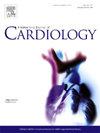The one-minute sit-to-stand test is an alternative to the 6-minute walk test in patients with atrial fibrillation: A cross-sectional study and ROC curve analysis
IF 3.2
2区 医学
Q2 CARDIAC & CARDIOVASCULAR SYSTEMS
引用次数: 0
Abstract
Background
The one-minute sit-to-stand test (1STST) is an easy-to-administer, space and time-saving test for determining functional exercise capacity in cardiac disease. This study aimed to investigate the 1STST -test-retest reliability and convergent validity and compare its physiological responses to the six-minute walk test (6MWT) in patients with Atrial fibrillation (AF).
Methods
Forty-five patients with AF were included in this study. Functional exercise capacity was evaluated using the 1STST and 6MWT. For assessing test-retest reliability, the intraclass correlation coefficient and Bland-Altman plots were utilised. Convergent validity was determined by correlation analysis 1 STST and 6MWT, age, European Heart Rhythm Association score, ejection fraction, and quality of life. The cut-off point of 1STST was defined using ROC analysis.
Results
With an intraclass correlation coefficient value of 0.975 [95 % confidence interval (CI) 0.954–0.986], the 1STST demonstrated excellent-test-retest reliability. Physiological responses after tests were similar in the 1STST and 6MWT (p > 0.05). The number of 1STST repetitions was strongly associated with 6MWT distance (r = 0.809; p < 0.001). A cut-off value of ≤13 repetitions in the number of 1STST repetitions was defined as functional impairment related to an increased risk of clinical events [sensitivity: 100 %, specificity: 84.6 %; AUC:0.94; 95 % CI 0.82 to 0.98; p < 0.001].
Conclusions
The 1STST is a reliable and valid assessment tool that produced comparable hemodynamic responses to the 6MWT in patients with AF. Considering its feasibility and time efficiency, healthcare professionals can use the 1STST rather than the 6MWT test to measure functional exercise status in a constrained environment for this patient group.
一分钟坐立测试可替代心房颤动患者的 6 分钟步行测试:横断面研究和 ROC 曲线分析。
背景:一分钟坐立测试(1STST)是一种易于操作、节省空间和时间的测试方法,可用于确定心脏病患者的功能锻炼能力。本研究旨在调查 1STST 的重测可靠性和收敛有效性,并比较其与六分钟步行测试(6MWT)在心房颤动(AF)患者中的生理反应:本研究共纳入 45 名房颤患者。方法:本研究共纳入 45 名房颤患者,使用 1STST 和 6MWT 评估其功能锻炼能力。采用类内相关系数和 Bland-Altman 图评估测试-重复测试的可靠性。通过对 1STST 和 6MWT、年龄、欧洲心脏节律协会评分、射血分数和生活质量进行相关分析,确定了收敛有效性。通过 ROC 分析确定了 1STST 的临界点:1STST 的类内相关系数为 0.975 [95 % 置信区间 (CI) 0.954-0.986],显示出极佳的重测可靠性。1STST 和 6MWT 测试后的生理反应相似(P > 0.05)。1STST 重复次数与 6MWT 距离密切相关(r = 0.809;p 结论:1STSTST 是一种可靠的测试方法:1STST 是一种可靠、有效的评估工具,对房颤患者产生的血液动力学反应与 6MWT 相当。考虑到其可行性和时间效率,医护人员可以在有限的环境中使用 1STST 而不是 6MWT 测试来测量该患者群体的功能锻炼状况。
本文章由计算机程序翻译,如有差异,请以英文原文为准。
求助全文
约1分钟内获得全文
求助全文
来源期刊

International journal of cardiology
医学-心血管系统
CiteScore
6.80
自引率
5.70%
发文量
758
审稿时长
44 days
期刊介绍:
The International Journal of Cardiology is devoted to cardiology in the broadest sense. Both basic research and clinical papers can be submitted. The journal serves the interest of both practicing clinicians and researchers.
In addition to original papers, we are launching a range of new manuscript types, including Consensus and Position Papers, Systematic Reviews, Meta-analyses, and Short communications. Case reports are no longer acceptable. Controversial techniques, issues on health policy and social medicine are discussed and serve as useful tools for encouraging debate.
 求助内容:
求助内容: 应助结果提醒方式:
应助结果提醒方式:


